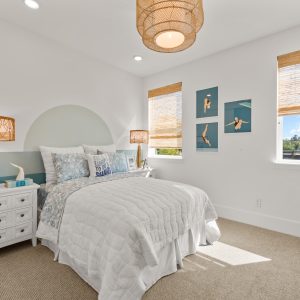Child-Friendly Features: Designing a Safe and Fun Environment

Designing a home that is both safe and fun for children is an important consideration for many growing families. A child-friendly environment not only nurtures a child’s physical and emotional well-being, it also fosters their creativity and development. The integration of child-friendly features into home design and construction is an endeavor that involves planning, careful selection of materials, and strategic layout.
The Importance of Child-Friendly Home Design
Designing a child-friendly home is not merely a matter of aesthetics; it’s a holistic approach that takes into account a child’s physical, emotional, and cognitive development. Here are some compelling reasons why child-friendly home design is so important:
Safety Concerns
Safety is the foremost concern when it comes to designing a child-friendly home. Children are naturally curious and often unaware of potential hazards. A well-designed child-friendly home minimizes risks by making sure sharp edges, toxic materials, and dangerous objects are out of reach or made child-resistant.
Encouraging Exploration
Children thrive in environments that encourage exploration and learning. Child-friendly features in the home stimulate a child’s natural curiosity and provide them with opportunities to discover, play, and grow.
Social and Emotional Development
Child-friendly homes are designed to promote social interaction and emotional development. Spaces that encourage family bonding and foster a sense of security can have a lasting impact on a child’s emotional well-being.
Durability – Because Kids Play Hard
Children can be rough on furniture and surfaces. Child-friendly home design takes into account the wear and tear that little ones can impose. Durable materials and finishes are chosen to withstand the test of time.
Adaptability – As they Grow
Child-friendly homes are adaptable to a child’s changing needs. As children grow, their requirements change. Designing with adaptability in mind allows the space to accommodate those changes seamlessly.
Child-Friendly Features in Home Design
Creating a child-friendly environment involves incorporating features that enhance safety, comfort, and enjoyment. Here are some child-friendly features to consider when designing and building your home:
Childproofing
Childproofing measures should be implemented throughout the home. These include safety latches on cabinets, outlet covers, corner guards on furniture, and safety gates for stairs. Childproofing creates a secure environment and minimizes the risk of accidents.
Play Areas
Designate specific areas of the home as play zones. These spaces can be furnished with age-appropriate toys and learning materials. Incorporate storage solutions such as bins or shelves to keep toys organized and accessible.
Soft Flooring
In areas where children are likely to play, consider soft flooring options like foam mats or carpets. Soft flooring minimizes the risk of injury if a child falls and provides a comfortable surface for play.
Child-Height Fixtures
Child-friendly features also include fixtures and furniture tailored to children’s height. Lower hooks, shelves, and child-sized furniture create a sense of independence and promote self-sufficiency.
Natural Light
Natural light is vital for a child’s development. Design your home to maximize natural light by incorporating large windows and skylights. A well-lit space contributes to a cheerful and inviting atmosphere.
Outdoor Space
If possible, create a child-friendly outdoor space where children can play and explore safely. Incorporate age-appropriate play equipment, a sandbox or a garden area for children to cultivate their connection with nature.
Open Layout
An open floor plan allows for better supervision of children and promotes family togetherness. It also creates an inviting and versatile space for play and relaxation.
Child-Safe Materials
Choose child-safe materials for construction and furnishings. Non-toxic, lead-free, and easy-to-clean materials are best. Also, consider fabrics and finishes that are resistant to stains and wear.
Comfortable Seating
Incorporate comfortable seating areas where parents and children can spend quality time together. Cozy reading nooks, window seats, and comfortable sofas create a sense of comfort and connection.
Storage Solutions
A clutter-free space is important for a child’s well-being. Incorporate ample storage solutions to keep toys, books, and belongings organized. Open shelving and cubbies make it easy for children to access and put away their items.
Building a Child-Friendly Home
When building a child-friendly home, involve professionals who specialize in family-oriented design. Architects, interior designers, and contractors experienced in creating child-friendly spaces can guide you through the process. Here are some things to consider:
Safety Standards
Adhere to safety standards and building codes to make sure that the home is free from hazards. Consider installing safety locks on windows and doors, securing heavy furniture, and equipping stairs with handrails (if they aren’t already).
Material Selection
Choose materials that are easy to clean and maintain, such as stain-resistant fabrics and durable flooring. Opt for finishes that are safe for children and non-toxic.
Energy Efficiency
Design the home to be energy-efficient, not only for environmental reasons but also to create a comfortable living environment. Proper insulation and energy-efficient windows keep the home warm in winter and cool in summer.
Flexibility
Design with adaptability in mind. As children grow and their needs change, the home should be able to accommodate those changes. Consider flexible spaces that can be easily transformed as children mature.
Consultation
Collaborate with professionals who understand child-friendly design principles. Architects and designers can help create a layout and design that caters to children’s needs and safety.
Designing and building a child-friendly home is a fulfilling endeavor that prioritizes the safety, comfort, and enjoyment of the children in the household. By considering child-friendly features and involving professionals with expertise in family-oriented design, you can create a living space that nurtures your child’s growth and development. A child-friendly home is not only a safe haven for children but also a place where families can bond, learn, and create cherished memories together.
